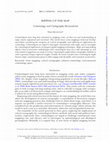Journal articles by Theo Kindynis

Theoretical Criminology, 2020
Drawing together recent theoretical work from both within and beyond criminology, this article co... more Drawing together recent theoretical work from both within and beyond criminology, this article considers the role of strategically designed consumer spaces in eliciting potentially criminogenic and harmful dispositions and behaviours. First, the article introduces recent work in cultural geography and urban studies, which has drawn attention to the manipulation of affect through spatial design. Second, by way of example, the article considers how such strategies are deployed in three types of consumer environments: shopping malls and retail spaces; casinos and other gambling environments; and the so-called night time economy. Third, the article engages such developments theoretically. It is suggested we rethink the distinctions and interrelationships between human subjectivity and agency and the built environment. The implications of this proposed conceptual reorientation are explored-first, for our understandings of agency, intentionality, moral responsibility and political accountability; and second, for criminological thinking around embodied difference, power and exclusion.

Crime Media Culture , 2017
Based on several years of near-nightly excursions into London's disused, non-public, forgotten, s... more Based on several years of near-nightly excursions into London's disused, non-public, forgotten, subterranean and infrastructural spaces, this article considers the significance of discovering years-or even decades-old surviving traces of graffiti ('ghosts', in graffiti parlance) in situ. The article also draws on extensive ethnographic research into London's graffiti subculture, as well as in-depth semi-structured interviews with several generations of graffiti writers. The article proceeds in four parts. The first part reflects on three sources of methodological inspiration: unauthorised urban exploration and documentation; more-or-less formal archaeological studies of graffiti; and 'ghost ethnography', an emergent methodological orientation which places an emphasis on absence and the interpretation of material and atmospheric traces. The second part of the article considers recent theoretical work associated with the 'spectral turn'. Here, ghosts and haunting provide useful conceptual metaphors for thinking about lingering material and atmospheric traces of the past. The third part of the article offers some methodological caveats and reflections. The fourth and final part of the article seeks to connect theory and method, and asks what significance can be drawn from unauthorised encounters with graffiti 'ghosts'.
British Journal of Criminology
Based on three years of ethnographic research undertaken in London amongst a loose network of wha... more Based on three years of ethnographic research undertaken in London amongst a loose network of what British Transport Police term 'serious graffiti vandals', this article considers how we might conceive theoretically of the interrelationships between graffiti writing, urban space and social control. The article proceeds in two parts. By way of introduction, the first half of the article delineates some of the major subcultural elements that comprise the day-today practice of graffiti writing as it exists in present-day London. The second half of the article engages the theoretical work of Henri Lefebvre. It is suggested that graffiti can be understood as simultaneously disrupting authoritative spatial orderings, whilst superimposing its own alternative social geography onto the city.
Recreational trespass or 'urban exploration' (UE) is the practice of researching, gaining access ... more Recreational trespass or 'urban exploration' (UE) is the practice of researching, gaining access to and documenting forbidden, forgotten or otherwise off-limits places, including abandoned buildings , construction sites and infrastructure systems. Over the past two decades, a global subculture has coalesced around this activity. More recently, however, the practice has begun to transform along divergent lines. The aims of the present article are threefold: first, to bring UE and its emergent variants to the attention of a criminological audience; second, to interrogate increasingly spectacular visual representations of UE and attendant processes of commodification; and third, to introduce the rhizome as a way of thinking about urban social formations, their development and appropriation.
Crime, Media, Culture, 2015
This article is an autoethnographic account of the authors’ trespassing in the abandoned Maze Pri... more This article is an autoethnographic account of the authors’ trespassing in the abandoned Maze Prison in Northern Ireland. For three decades before its closure in 2000, the Maze was the site of intense political struggle. The ruins of the Maze – a space once built to let no one out that now allows no one in – exist now in a state of limbo, between the conflicting narratives of the prison’s troubled past, and an uncertain future. We present a brief historical account of the Maze, and explain our unconventional choice of ‘research method’, before introducing Foucault’s notion of the heterotopia. We suggest that the Maze is an archetypally heterotopic space and our experience of exploring the prison can equally be described as such.

British Journal of Criminology
Criminologists have long been interested in mapping crime, yet their use and understanding of map... more Criminologists have long been interested in mapping crime, yet their use and understanding of maps remain superficial and uncritical. This article traces crime mapping’s historical development before considering the emergence of ‘critical cartography’ and exploring its implications for criminology. Criminologists are urged to interrogate conventional crime maps, and to investigate the criminological implications of emergent digital mapping technologies. Maps and map making afford a host of innovative methodologies that criminologists have yet to take advantage of, and some tentative suggestions are made as to how criminologists might utilize cartographic methods in order to generate unique empirical insights. Finally, the article considers how criminologists might harness maps’ communicative power to better engage with the public and to promote social justice.
Book sections by Theo Kindynis
Conference papers by Theo Kindynis

Crossrail is Europe's largest infrastructure project, a new high-speed subway route being built u... more Crossrail is Europe's largest infrastructure project, a new high-speed subway route being built underneath central London. The system comprises a complex subterranean network of tunnels, ventilation shafts, caverns and junctions insinuated – burrowed – within the dense meshwork of infrastructure already entangled beneath the streets of London (Victorian sewers, the London Underground network, gas pipes, electricity and fibre optic cables). In Deleuze and Guattari's terminology, infrastructure comprises an archetypally "striated space", wherein flows are channelled and harnessed by the State. Although urban infrastructure networks shape urban life perhaps to a greater degree than ever, such systems are almost entirely invisible, rendering opaque the 'social relations and power mechanisms that are scripted in and enacted through these flows' (Kaika and Swyngedouw, 2000: 121). However, these hidden spaces are rarely unequivocal, and their functions are seldom totalising. The Crossrail megaproject literally comprises a series of holes bored through the urban subsurface – yet to what extent can this infrastructural rhizome be described as a "holey space" in the Deleuzoguattarian sense? A conception of the city as porous facilitates an understanding of how alternative uses, meanings and counter-narratives can emerge from holes in the existing order. As Crossrail's reterritorialisation of London continues apace, how are we to make sense of this transformation? Based on ongoing research, this paper considers what kinds of literally and figuratively subterranean practices and imaginaries might emerge from this most peculiar of spaces.

Criminologists have long taken space for granted as an inert material backdrop, or an aesthetic s... more Criminologists have long taken space for granted as an inert material backdrop, or an aesthetic surface upon which criminal activities can be mapped, rather than a product of complex social, political and cultural dynamics, (Campbell, 2013). In recent years, a “spatial turn” within criminology has given rise to more textured and nuanced renderings of the lived experience and socio-cultural complexities of (urban) space / crime (Hayward, 2004, 2012). However, this enterprise has thus far been a largely theoretical one.
Based on ongoing fieldwork amongst a network of what British Transport Police term “serious graffiti vandals”, this paper offers a novel theoretical contribution to this critical subfield of criminology, informed by in-depth empirical work. The paper considers how we might conceptualise graffiti writing – an often complex and contradictory practice – as well as the spaces it inhabits, and the subjectivities it articulates.
Drawing on the work of Gilles Deleuze and Felix Guattari, this paper suggests that graffiti writing occupies an interstitial “holey space”. Rather than acting against the State from outside, graffiti writers exploit the interstices, holes and fractures in the State’s “grid” of discipline; parasitising its infrastructure and spatialisations. It is suggested that much like the spaces it occupies, the practice of graffiti writing must be conceived of as hybrid, liminal and ambiguous.

Criminologists have long taken space for granted as an inert material backdrop, or an aesthetic s... more Criminologists have long taken space for granted as an inert material backdrop, or an aesthetic surface upon which criminal activities can be mapped, rather than a product of complex social, political and cultural dynamics, (Campbell, 2013). In recent years, the “spatial turn” within criminology has given rise to more textured and nuanced rendering of the lived experience and socio-cultural complexities of (urban) space / crime (Hayward, 2004, 2012). However, this enterprise has thus far been a largely theoretical one.
Based on ongoing fieldwork among a network of what British Transport Police term “serious graffiti vandals”, this paper offers a novel theoretical contribution to this critical subfield of criminology, informed by in-depth empirical work. Employing a theoretical synthesis of the work of Henri Lefebvre and that of Gilles Deleuze and Felix Guattari, this paper positions graffiti writing as a nuanced and sophisticated spatial practice, as much to do with the social and symbolic production of space as the “destruction” of material property. It is argued that graffiti writing both disrupts authoritative State cartographies and superimposes its own subaltern geographies of meaning, identity and power. Furthermore, if calls for social and political transformation are futile without the production of an appropriate space (Lefebvre, 1991), what might we learn from the clandestine geographies of graffiti writers?

Critical and cultural criminologists have, in recent years, begun to address the various interrel... more Critical and cultural criminologists have, in recent years, begun to address the various interrelationships between criminality and consumer culture (Hayward, 2004; Hall et al., 2008), whilst at the same time offering more nuanced and textured accounts of the lived experience and socio-cultural complexities of urban space / crime (Hayward, 2012; Campbell, 2013). At the forefront of much of this research has been a concern with phenomenology, identity and emotion (Ferrell et al., 2008), yet the relationship between these aspects of subjectivity and space remains uncertain. This paper introduces the notion of affect – a pre-conscious, visceral, but not neatly corporeal force of relationality, transmitted between bodies and across spaces (Massumi, 2002; Thrift, 2008) – and considers it’s relevance for criminologists in thinking through the connections between space, crime and control. The paper considers contemporary retail environments as an example of how urban space – atmosphere, architecture and design – is now increasingly being enrolled as a medium of bio-political control through the engineering of affect. Drawing on ongoing ethnographic fieldwork with a group of shoplifters in London, the paper then reflects on how considerations of affect, and the ‘ethological’ approach (Deleuze, 1992) common to affective and actor-network theories, might reframe our understandings of crime, space, motivation and transgression.
Book Reviews by Theo Kindynis

Crime Media Culture
Criminology has long adhered to two-dimensional, superficial, lazy, taken-for-granted and often q... more Criminology has long adhered to two-dimensional, superficial, lazy, taken-for-granted and often quite frankly boring ways of thinking about urban space. From Guerry and Quetelet's 19th century cartes thematiques and the Chicago School's iconic 'concentric zone' model, to the latest developments in digital crime mapping, criminological conceptions of the metropolis have long exemplified what Michel de Certeau (1984) famously described as the 'concept city': the city as it is 'seen by planners, developers, statisticians … distilled to leave only quantitative data, demographics and rational discourse' (Hayward, 2004: 2). All too often, criminologists have tended to regard the urban mise-en-scène of crime and social control -the built environment of the city -as an empty container, 'an inert material backdrop, or an aesthetic surface upon which criminal activities can be mapped' (Campbell, 2013: 18;. As a result, criminological understandings of urban space -at once the immediate, physical and phenomenological context of crime; increasingly a medium of social control; and repeatedly the object of political struggle -remain fundamentally underdeveloped and inadequate.








Uploads
Journal articles by Theo Kindynis
Book sections by Theo Kindynis
Conference papers by Theo Kindynis
Based on ongoing fieldwork amongst a network of what British Transport Police term “serious graffiti vandals”, this paper offers a novel theoretical contribution to this critical subfield of criminology, informed by in-depth empirical work. The paper considers how we might conceptualise graffiti writing – an often complex and contradictory practice – as well as the spaces it inhabits, and the subjectivities it articulates.
Drawing on the work of Gilles Deleuze and Felix Guattari, this paper suggests that graffiti writing occupies an interstitial “holey space”. Rather than acting against the State from outside, graffiti writers exploit the interstices, holes and fractures in the State’s “grid” of discipline; parasitising its infrastructure and spatialisations. It is suggested that much like the spaces it occupies, the practice of graffiti writing must be conceived of as hybrid, liminal and ambiguous.
Based on ongoing fieldwork among a network of what British Transport Police term “serious graffiti vandals”, this paper offers a novel theoretical contribution to this critical subfield of criminology, informed by in-depth empirical work. Employing a theoretical synthesis of the work of Henri Lefebvre and that of Gilles Deleuze and Felix Guattari, this paper positions graffiti writing as a nuanced and sophisticated spatial practice, as much to do with the social and symbolic production of space as the “destruction” of material property. It is argued that graffiti writing both disrupts authoritative State cartographies and superimposes its own subaltern geographies of meaning, identity and power. Furthermore, if calls for social and political transformation are futile without the production of an appropriate space (Lefebvre, 1991), what might we learn from the clandestine geographies of graffiti writers?
Book Reviews by Theo Kindynis
Based on ongoing fieldwork amongst a network of what British Transport Police term “serious graffiti vandals”, this paper offers a novel theoretical contribution to this critical subfield of criminology, informed by in-depth empirical work. The paper considers how we might conceptualise graffiti writing – an often complex and contradictory practice – as well as the spaces it inhabits, and the subjectivities it articulates.
Drawing on the work of Gilles Deleuze and Felix Guattari, this paper suggests that graffiti writing occupies an interstitial “holey space”. Rather than acting against the State from outside, graffiti writers exploit the interstices, holes and fractures in the State’s “grid” of discipline; parasitising its infrastructure and spatialisations. It is suggested that much like the spaces it occupies, the practice of graffiti writing must be conceived of as hybrid, liminal and ambiguous.
Based on ongoing fieldwork among a network of what British Transport Police term “serious graffiti vandals”, this paper offers a novel theoretical contribution to this critical subfield of criminology, informed by in-depth empirical work. Employing a theoretical synthesis of the work of Henri Lefebvre and that of Gilles Deleuze and Felix Guattari, this paper positions graffiti writing as a nuanced and sophisticated spatial practice, as much to do with the social and symbolic production of space as the “destruction” of material property. It is argued that graffiti writing both disrupts authoritative State cartographies and superimposes its own subaltern geographies of meaning, identity and power. Furthermore, if calls for social and political transformation are futile without the production of an appropriate space (Lefebvre, 1991), what might we learn from the clandestine geographies of graffiti writers?